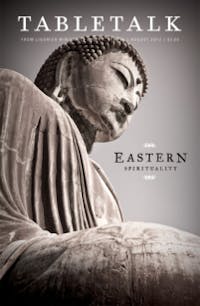
Request your free, three-month trial to Tabletalk magazine. You’ll receive the print issue monthly and gain immediate digital access to decades of archives. This trial is risk-free. No credit card required.
Try Tabletalk NowAlready receive Tabletalk magazine every month?
Verify your email address to gain unlimited access.
I cannot count the number of times I’ve heard, “I believe there’s a little bad in all that’s good and a little good in all that’s bad.” The problem is not the number of times I’ve heard this but that I’ve heard it most often from professing Christians. While I assume most are unaware, the statement is deeply rooted in Eastern mysticism and strikes against the very heart of the Christian faith, which asserts unequivocally that our triune God is altogether righteous and the sovereign Judge over all that’s evil.
The Yin-Yang (yīnyáng) philosophy of Taoism espouses that there are opposing but interconnected forces of light and dark, good and evil, that compose and govern the universe. The dualistic interaction of these two Feng Shui (fŭng shwā) forces creates the essence of an enlightened life; thus, we must seek to bring balanced harmony in all of life through various means, such as yoga, focused breathing (prāṇāyāma), Feng-Shui-designed living spaces, and calming colors, sounds, and scents.
In the West, we have embraced a syncretized hybrid form of Eastern spirituality, yielding a seemingly more innocent form of mysticism but, in reality, a more deceptive and, thus, far more dangerous form. We have not only syncretized Taoism, Hinduism, and Buddhism, we have thrown Christianity into the mix, attempting to make ourselves seem more culturally enlightened and less narrowly biblically intolerant. While all this may come as news to some, Eastern mysticism is rapidly, yet subtly, spreading through the heartland of America, and it is absolutely essential that we begin to recognize the danger Eastern mysticism poses.
If all this seems a bit far-fetched, I offer the following examples of the infiltration of Eastern mysticism into our society and, more to the point, our churches. Not long ago, a woman from America’s Bible-belt proudly informed me she was a Christian-Buddhist. I recently heard of a Christian preschool teacher leading her class in breathing meditation exercises as the children repeat the sound Buddhist monks echo when in prayer. A few years ago, a teacher in a conservative Reformed congregation was instructing his high school students about the principle of Yin-Yang, drawing for them the symbol of the Tao on the whiteboard. Just last week, I learned that the fourteenth Dalai Lama of Tibetan Buddhism went on a speaking tour of America’s schools last spring.
Eastern spirituality is no longer merely in the East. It has made its way to our shores and is creeping its way into our homes through Hollywood and may soon be in our pulpits. We must be on guard and ready to give an answer for the hope that is within us, the only hope for the world—not that we become enlightened gods but that the Son of God took on a human nature and lived and died for us that we might live forever.
